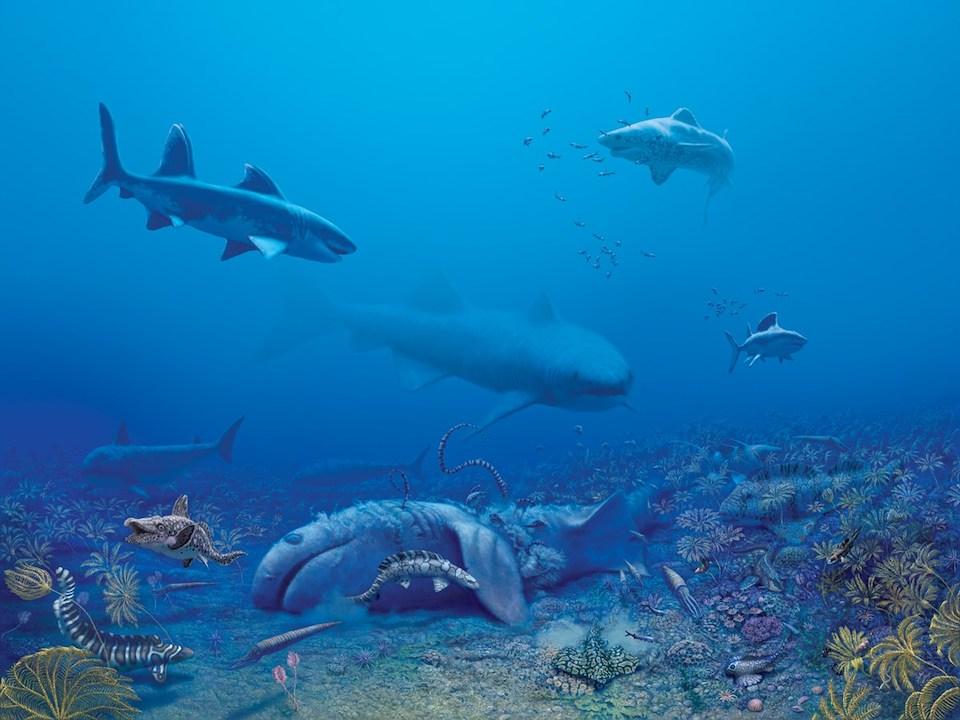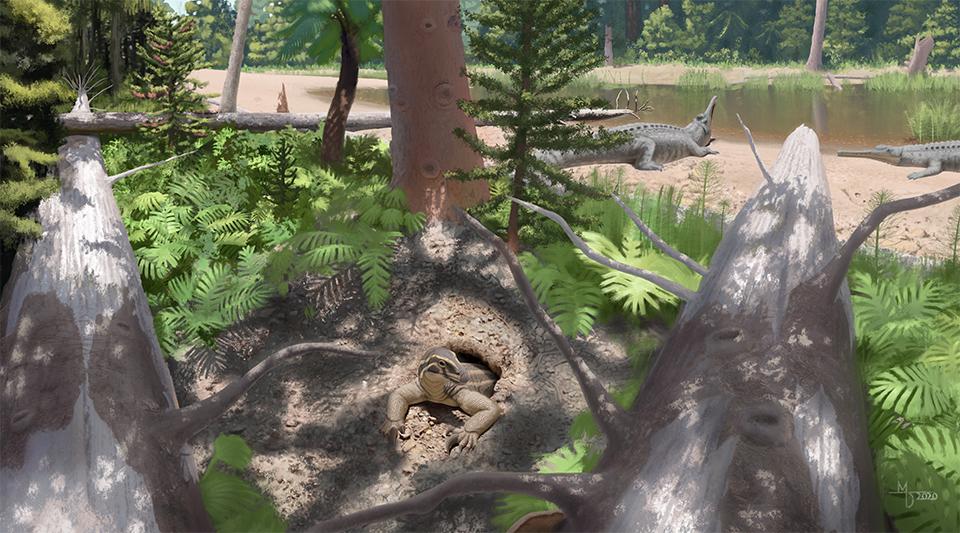
The Mississippian age (325 MYA) ancient sea and marine life preserved at Mammoth Cave National Park/NPS, painting by Julius Csotonyi
When you go on a wild cave tour at Mammoth Cave National Park, shimmying around on your hands and knees, you'd never think to watch for sharks. Nor when you explore Petrified Forest National Park and marvel at the colorful rock-solid slabs of wood, you won't sense a need to watch for any burrowing reptiles. But, as it turns out, those creatures did live in those landscapes...once upon a time.
Those animals in those places are evidence that, despite the many decades that people, researchers, and scientists have been visiting and exploring these two parks, there are many secrets and mysteries waiting in the National Park System to be revealed.
At Mammoth Cave in Kentucky, a team of paleontologists, cave specialists, and rangers recently discovered a trove of fossils that yielded one of the most diverse Mississippian shark faunas in North America, according to a park release. At least 40 different species of sharks and their relatives have been identified, including six species possibly new to science, the release added.
"Rare preservation of three-dimensional skeletal cartilage documented in Mammoth Cave allows us to understand the anatomy and relationships of these ancient sharks," the staff says. "The discoveries in remote cave locations within the park were made during an ongoing paleontological resources inventory that began in November 2019. Mammoth Cave is known for a variety of ice age mammal fossils as well as ancient marine organisms."
The 325 million-year-old fossil-rich limestones of the Mammoth Cave system were formed during the Late Paleozoic, a time period known to geologists as the Mississippian Period. The park staff reported a few fossil shark teeth exposed in the cave walls of Ste. Genevieve Limestone in several locations. Fossil shark specialist John-Paul (JP) Hodnett of the Maryland-National Capital Parks and Planning Commission was recruited to help identify the shark fossils, which were primarily teeth and fin spines. Since most of the skeleton of sharks is composed of cartilage, rather than bone, the skeletons of sharks are rarely preserved as fossils.
Hodnett and park staff discovered and identified many different species of primitive sharks from specimens in the rocks lining the cave passages in Mammoth Cave.
“I am absolutely amazed at the diversity of sharks we see while exploring the passages that make up Mammoth Cave," said Hodnett. "We can hardly move more than a couple of feet as another tooth or spine is spotted in the cave ceiling or wall. We are seeing a range of different species of chondrichthyans [cartilaginous fish] that fill a variety of ecological niches, from large predators to tiny little sharks that lived amongst the crinoid [sea lily] forest on the seafloor that was their habitat.”
Most of the shark fossils have been discovered in areas inaccessible to visitors on cave tours, but park staff are preparing photographs, artists’ renditions, and three-dimensional models for the visitors to view and explore in park exhibits.
In addition to this rich diversity of primitive sharks at Mammoth Cave, two partial cartilaginous skeletons of different species of sharks were also found within Mammoth Cave. One specimen was discovered by a caver with the Cave Research Foundation and the other has been known by the park guides for years. The preservation of cartilage in layers of Paleozoic rock is a very rare occurrence and moved the team to thoroughly document these specimens.
National Park Service geologist Jack Wood lugged equipment through narrow cave passages to capture photogrammetric images of the two rare specimens. Wood produced 3-D models of the cartilaginous shark remains that are posted on the National Park Service website.
“We are very excited to find such an important set of fossils at the park. Although we have known that we had a few shark teeth in the limestone exposed in the cave, we never imagined that we would have the abundance and diversity of sharks that JP Hodnett has identified,” said Rick Toomey, the park's cave resource management specialist and research coordinator.
Paleontological resource inventories, similar to the one underway at Mammoth Cave National Park, have helped to document fossils in at least 277 different national parks throughout the United States.
"Paleontological resource inventories are fundamental to the management of non-renewable fossils. These inventories enable us to establish baseline fossil data capturing the scope, significance, distribution, and management issues related to park fossils," said Vince Santucci, the Park Service's senior paleontologist. "Many new and important fossil discoveries are tied to field inventories, as demonstrated at Mammoth Cave National Park, expanding our understanding of the fossil record in the national parks.”

The new species of drepanosaur, Skybalonyx skapter, emerging from a burrow in the Late Triassic at Petrified Forest/NPS, art used with permission by Midiaou Diallo
In Arizona at Petrified Forest, staff last week announced the discovery of a species of a 220 million-year-old burrowing reptile known as a drepanosaur. This species, named Skybalonyx skapter by a collaborative team of researchers from Petrified Forest National Park, Virginia Tech, University of Washington, Arizona State University, Idaho State University, and the Virginia Museum of Natural History, was announced on October 8th in a study published in the Journal of Vertebrate Paleontology.
"Drepanosaurs are a strange group of ancient reptiles known from Triassic rocks of the Northern Hemisphere and possessed an array of strange morphologies including enlarged second claws, bird-like beaks, and tails ending with a claw," said park staff. "They probably looked like a combination of an anteater and a chameleon, and Skybalonyx may have been even stranger."
The fossils of Skybalonyx are so small that they are difficult to find using normal paleontological field methods and were fortunately discovered by the Petrified Forest crew using a new method of screen-washing fossiliferous rock, in which rocks are broken down with water through a series of metal screens. This study analyzed the hand claws of modern animals and found that Skybalonyx has claws most similar to burrowing animals such as moles, echidnas, and mole-rats, much different than other drepanosaurs that have claws suited for climbing and living in trees. This new species was described as a result of the parks ongoing summer paleontology internships by intern Xavier Jenkins and colleagues. Xavier is now a first-year Ph.D. student at Idaho State University, where he is studying the functional morphology of Permian and Triassic aged tetrapods.



Add comment